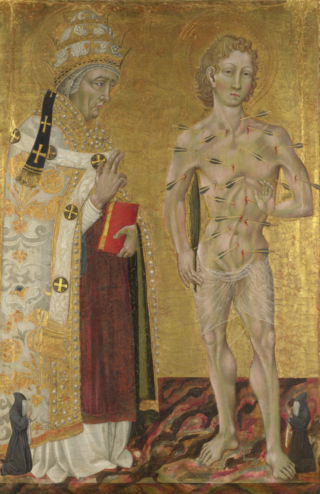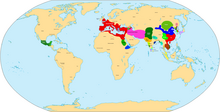The 300s decade ran from January 1, 300, to December 31, 309.
The 310s decade ran from January 1, 310, to December 31, 319.
The 530s decade ran from January 1, 530, to December 31, 539.
The 270s decade ran from January 1, 270, to December 31, 279.
The 340s decade ran from January 1, 340, to December 31, 349.
Year 538 (DXXXVIII) was a common year starting on Friday of the Julian calendar. At the time, it was known as the Year of the Consulship of Iohannes without colleague. The denomination 538 for this year has been used since the early medieval period, when the Anno Domini calendar era became the prevalent method in Europe for naming years.

Year 251 (CCLI) was a common year starting on Wednesday of the Julian calendar. At the time, it was known as the Year of the Consulship of Traianus and Etruscus. The denomination 251 for this year has been used since the early medieval period, when the Anno Domini calendar era became the prevalent method in Europe for naming years.

Year 257 (CCLVII) was a common year starting on Thursday of the Julian calendar. At the time, it was known as the Year of the Consulship of Valerianus and Gallienus. The denomination 257 for this year has been used since the early medieval period, when the Anno Domini calendar era became the prevalent method in Europe for naming years.
The 250s was a decade that ran from January 1, 250, to December 31, 259.

Year 303 (CCCIII) was a common year starting on Friday of the Julian calendar. It was known in the Roman Empire as the Year of the Consulship of Diocletian and Maximian. The denomination 303 for this year has been used since the early medieval period, when the Anno Domini calendar era became the prevalent method in Europe for naming years.
Year 256 (CCLVI) was a leap year starting on Tuesday of the Julian calendar. At the time, it was known as the Year of the Consulship of Claudius and Glabrio. The denomination 256 for this year has been used since the early medieval period, when the Anno Domini calendar era became the prevalent method in Europe for naming years.
Year 258 (CCLVIII) was a common year starting on Friday of the Julian calendar. At the time, it was known as the Year of the Consulship of Tuscus and Bassus. The denomination 258 for this year has been used since the early medieval period, when the Anno Domini calendar era became the prevalent method in Europe for naming years.

Year 180 (CLXXX) was a leap year starting on Friday of the Julian calendar. At the time, it was known as the Year of the Consulship of Rusticus and Condianus. The denomination 180 for this year has been used since the early medieval period, when the Anno Domini calendar era became the prevalent method in Europe for naming years.
Year 340 (CCCXL) was a leap year starting on Tuesday of the Julian calendar. At the time, it was known as the Year of the Consulship of Acindynus and Valerius. The denomination 340 for this year has been used since the early medieval period, when the Anno Domini calendar era became the prevalent method in Europe for naming years.

Year 315 (CCCXV) was a common year starting on Saturday of the Julian calendar. At the time, it was known as the Year of the Consulship of Constantinus and Licinianus. The denomination 315 for this year has been used since the early medieval period, when the Anno Domini calendar era became the prevalent method in Europe for naming years.

Pope Fabian was the bishop of Rome from 10 January 236 until his death on 20 January 250, succeeding Anterus. A dove is said to have descended on his head to mark him as the Holy Spirit's unexpected choice to become the next pope. He was succeeded by Cornelius.

Pope Cornelius was the bishop of Rome from 6th or 13th March 251 until his martyrdom in June 253. He was pope during and following a period of persecution of the church, while a schism occurred over how repentant church members who had practiced pagan sacrifices to protect themselves could be readmitted to the church. He agreed with Cyprian of Carthage that those who had lapsed could be restored to communion after varying forms of Reinitiation and Penance. This position was in contrast to the Novatianists, who held that those who failed to maintain their confession of faith under persecution would not be received again into communion with the church. This resulted in a short-lived schism in the Church of Rome that spread as each side sought to gather support. Cornelius held a synod that confirmed his election and excommunicated Novatian, but the controversy regarding lapsed members continued for years.

Gaius Messius Quintus Trajanus Decius, sometimes translated as Trajan Decius, was Roman emperor from 249 to 251.
Novatian was a scholar, priest, and theologian. He is considered by the Catholic Church to have been an antipope between 251 and 258. Some Greek authors give his name as Novatus, who was an African presbyter.
The Plague of Cyprian was a pandemic that afflicted the Roman Empire from about AD 249 to 262, or 251/2 to 270. The plague is thought to have caused widespread manpower shortages for food production and the Roman army, severely weakening the empire during the Crisis of the Third Century. Its modern name commemorates St. Cyprian, bishop of Carthage, an early Christian writer who witnessed and described the plague. The agent of the plague is highly speculative because of sparse sourcing, but suspects have included smallpox, measles, and viral haemorrhagic fever (filoviruses) like the Ebola virus.








